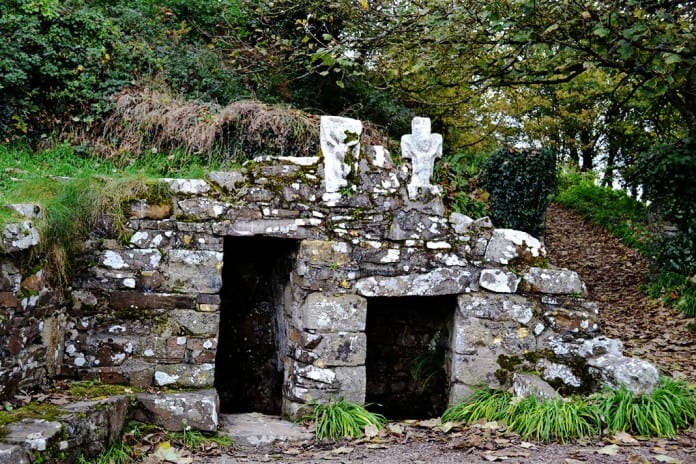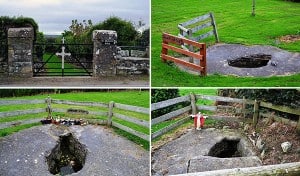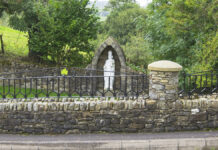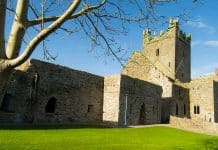
Centuries after they first started to appear, there are still many Holy Wells famed for their healing properties scattered across the British Isles. The majority of these – around three thousand – are in Ireland.
Many are naturally occurring springs, and others are tranquil open pools. Some boast a stone surrounding. Sadly, some lie forgotten, covered by brambles and no longer visited. However, many of these Holy Wells continue to be places of pilgrimage as they have been for thousands of years. These potent healing waters that the Celts believed were the home to goddesses, including Boann, continue to attract those seeking cures, those who require guidance or luck and those who simply want to enjoy the peace, serenity and almost otherworldly atmosphere that is so characteristic of the Holy Well sites.
Holy Wells of the Celts
The origins of the wells can be traced right back to Celtic times. The Celts influenced the native Irish in many ways, including in terms of their religious beliefs. They laid great emphasis on the ‘power of place’ – that is the belief that society and nature were inextricably linked and that certain physical sites possessed both regenerative and curative powers.
Site surveys have indicated that many of the well locations are formed of three distinct elements. These are the well itself, including the water source that serves it, an ancient and sizeable tree (often a hazel tree) and either a standing stone or a hill. These physical features played an important role in the rituals followed by the pilgrims who travelled to the sites seeking help or solace. Such rituals were known as ‘patterns’ and generally included a prescribed circular clockwise walk around the site. Today this ancient practice is echoed in the Christian ritual of ‘The Stations of the Cross’, in which worshippers follow a structured route around a church in a clockwise direction as a physical re-telling of the last earthly hours of Jesus Christ.
Traditions and Rituals
When physical circumstances allowed, other rituals that fitted in with the particular features of a site may also have taken place. For example, a number of wells are sited near a large flat stone with a depression in the centre. It is thought that women seeking help with fertility or other child-bearing issues would lie on these stones. In order to receive a blessing, pilgrims would rub the surface of any standing stones near the wells. A common ritual was to tie a scrap of cloth (known locally as a clootie) to the branches of the holy tree after bathing or washing in or drinking from the Holy Well. It was believed that this would drive any sickness into the fabric of the cloth, thus leaving it behind. At some wells, it was also common to throw a coin or a pin into the water as an offering.
Ancient pre-Christian myth tells that the springs that filled the wells originated in the ‘Otherworld’ – a sort of parallel universe that was believed to be a potent source of wisdom and of power.
A common motif that is found at many sites is the fish, which may originate from the belief that the water goddesses, who were believed to be at one with the water, sometimes took on the form of a fish. Legend told that the location of the Otherworld was variously deep under the sea, buried far down under the earth, concealed in a mound, lay far to the west or was permanently hidden from view in a thick mist. It was widely accepted that bathing in or drinking the water would confer the sacred powers of the Otherworld on the visitor in the way that best suited their need – as wisdom, as healing or as poetic inspiration.
Otherworld Portals Converted in Holy Wells
It was the arrival of St. Patrick and other Christian missionaries that changed the way that such wells were perceived. Perhaps the most iconic missionary that ever arrived in the country, St. Patrick reached the shores of Ireland sometime around the year 460 AD. He was determined to ‘Christianise’ the country and set about changing pagan rituals into Christian customs. He is said to have set an Easter bonfire in direct competition to the pagan one already burning on Slane Hill that had been lit by the king. The king was furious, but it is said that several people were converted to Christianity that day. Legend also tells us that St. Patrick used the three leaves of the shamrock to explain the Holy Trinity of Father, Son and Holy Spirit, although this is widely believed to be a myth.
Before Christianity started to take hold, the sacred well waters were a reflection of the Celtic belief that spirituality sprang from the earth itself. Indeed, the wells were such popular pagan sites of worship that at first the early Roman Church tried to eradicate them. However, as is often the way with such ancient belief systems, the form altered while the mysticism remained. The mysterious pagan wells simply transformed over time into sites of Christian pilgrimage. So the pagan tree metamorphosed into Christ’s cross, and the pagan fish came to be thought of as a predominantly Christian symbol.
A Place for Baptism
A great number of Christian churches were built near to the pagan well sites. In fact, the wells were used as baptism sites by the earliest Christian churches, until it was decreed that fonts should be set inside the church itself. Several very ancient churches contain a grotto or crypt that leads to an underwater spring.
Healing and Blessings

Many pilgrims flocked to the wells because they were reputed to heal the sick. Some wells had a particular specialism when it came to illness, with some catering for those with whooping cough, some tuberculosis, some fertility issues and still others for frail children or the insane. Recent studies have shown that these claims actually have some basis in fact. A number of the wells contain high quantities of particular minerals that can be beneficial to those suffering from certain health conditions. So, for example, wells that were famed for curing skin abnormalities often contained high levels of sulphur, which is used today to treat common skin complaints, including acne. Those wells that the worried mothers of the past brought their ailing children to tend to be iron-rich, and those that were thought to cure the insane have a high concentration of lithium – an element commonly used to treat mental illness today.
However, as anyone who has visited one of the Holy Wells seeking solace or cures may attest, the healing powers that may be found there are surely not just due to the chemical composition of the water. These sites also exude a sense of the mysticism that has so long been associated with moving water. This water is the legendary home of the goddess Boann and is, indeed, the source of all life.
Examples of Holy Wells are found right across Ireland, and though many are in a poor state of repair, there has recently been a real resurgence of interest in their fascinating heritage and history. What is certainly true is that the sites of these places absolutely resonate with character and charm. It seems likely that people will come seeking cures from the healing waters for years to come, perhaps lured by the splashes of Boann and her fellow goddesses of old.




